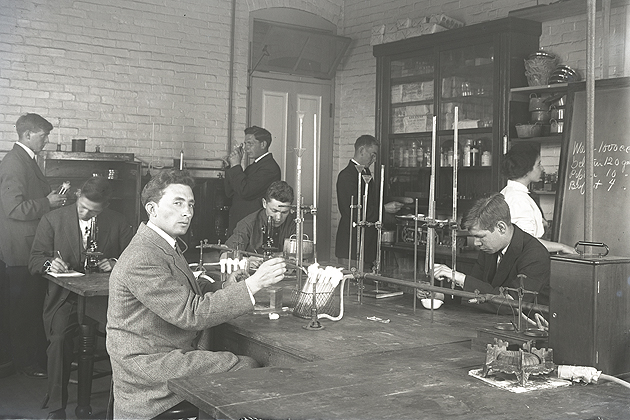It’s a curiosity: The University has three biology departments in the College of Liberal Arts and Sciences – Ecology and Evolutionary Biology (EEB), Physiology and Neurobiology (PNB), and Molecular and Cell Biology (MCB). Why so many?
One hears the biology question from freshmen, their parents, administrators, non-biology professors, and sometimes even from bewildered “biology” professors. UConn has departments of chemistry, physics, and mathematics, so why not a Department of Biology? The answer lies in the history of biological sciences at the Storrs campus, as well as in how biological disciplines evolved in America, starting in the 19th century.

When Connecticut started its first public institution of higher education, the Storrs Agricultural School, in 1881, chemistry and physics had been established as disciplines for most of the 19th century. They have remained single discipline departments at UConn. Physics arose in the tradition of natural philosophy, the study of the processes and features of the natural world. Chemistry also sprang from natural philosophy, with influence from the older pursuit of attempting to transform “base metals” into precious metals, i.e., alchemy. Consequently, chemistry and physics had origins as separate and cohesive disciplines.
The origins of biological sciences were more fractured. Biology research started in three fields: natural philosophy, agriculture, and medicine. In the 19th and early 20th centuries, researchers in each field were largely ignorant of each other’s methods and interests. Consequently, discoveries in one field were often unknown to those in other fields. For example, plant breeder Gregor Mendel’s 1866 report on pea plant inheritance patterns was unknown to most natural philosophers until the turn of the 20th century. Yet his findings helped establish the discipline of genetics.
The early separation of fields of biology partly explains why they have never coalesced into one discipline, either at the national level or at the departmental level at UConn. When the Storrs Agricultural School started in 1881, all sciences were part of its only curriculum, agriculture. Departments as we now know them only emerged in the late 1930s. Until then, individual professors reported to the Board of Trustees about the collection of courses that they taught. They called these collections “departments.” These could include odd collections of courses, like the 1898 entries for the Department of Botany and Military Science and the Department of Natural Science, Political Economy, and Civics.
In 1903, a general science curriculum appeared for the first time. Ornithology and entomology were split from the agriculture curriculum, though bacteriology (which appeared in 1901) and botany remained. A sciences curriculum separate from agriculture appeared and disappeared, as the debate over the purpose of the school changed. This debate was also reflected in the name of the institution that changed four times until it became the University of Connecticut in 1939.
In the late 1930s, the colleges (first called “divisions”) and majors that we know today appeared. In 1945, bacteriology, botany, and zoology were the biology departments in the College of Liberal Arts and Sciences. This organization remained until the 1960s.
Around 1970, the biological sciences were reorganized into a unique structure, a group with an executive director. The Biological Sciences Group was subdivided into five sections, each with a head. Undergraduate and graduate majors were named after the three former departments.
This department organization lasted until the mid 1970s, when the executive director became the head of biological sciences and the sections were no longer recognized as administrative units. The section names became the names of the undergraduate majors, along with a new general biology major. By 1980, the section-related majors disappeared, leaving only biological sciences and biophysics as majors.

Biological sciences did not last long as a department, however, perhaps because by 1985 it had 72 professors! In the mid-1980s, it was split into the three current departments: Ecology and Evolutionary Biology; Molecular and Cell Biology; and Physiology and Neurobiology. The undergraduate biological sciences major was retained, leaving it under the joint administration of the three departments. Graduate programs largely joined into single programs under each department’s new name, except for those under MCB. The five graduate programs overseen by the MCB faculty remained semi-autonomous. A recent joint agreement among them joins several of their common functions under a graduate program called Molecular and Cell Biology, while retaining each separate professional curriculum as an area of concentration.
Across the country, state universities have repeatedly separated or joined their biological sciences fields. At some larger public universities, biological sciences are joined in a separate college. As UConn grows, perhaps this is in our future, too. The history of the organization of biological sciences at UConn and its predecessors reflects not so much the parochial interests of its faculty and students, but the origin of each discipline and the dynamism of their sciences. Stay tuned.



